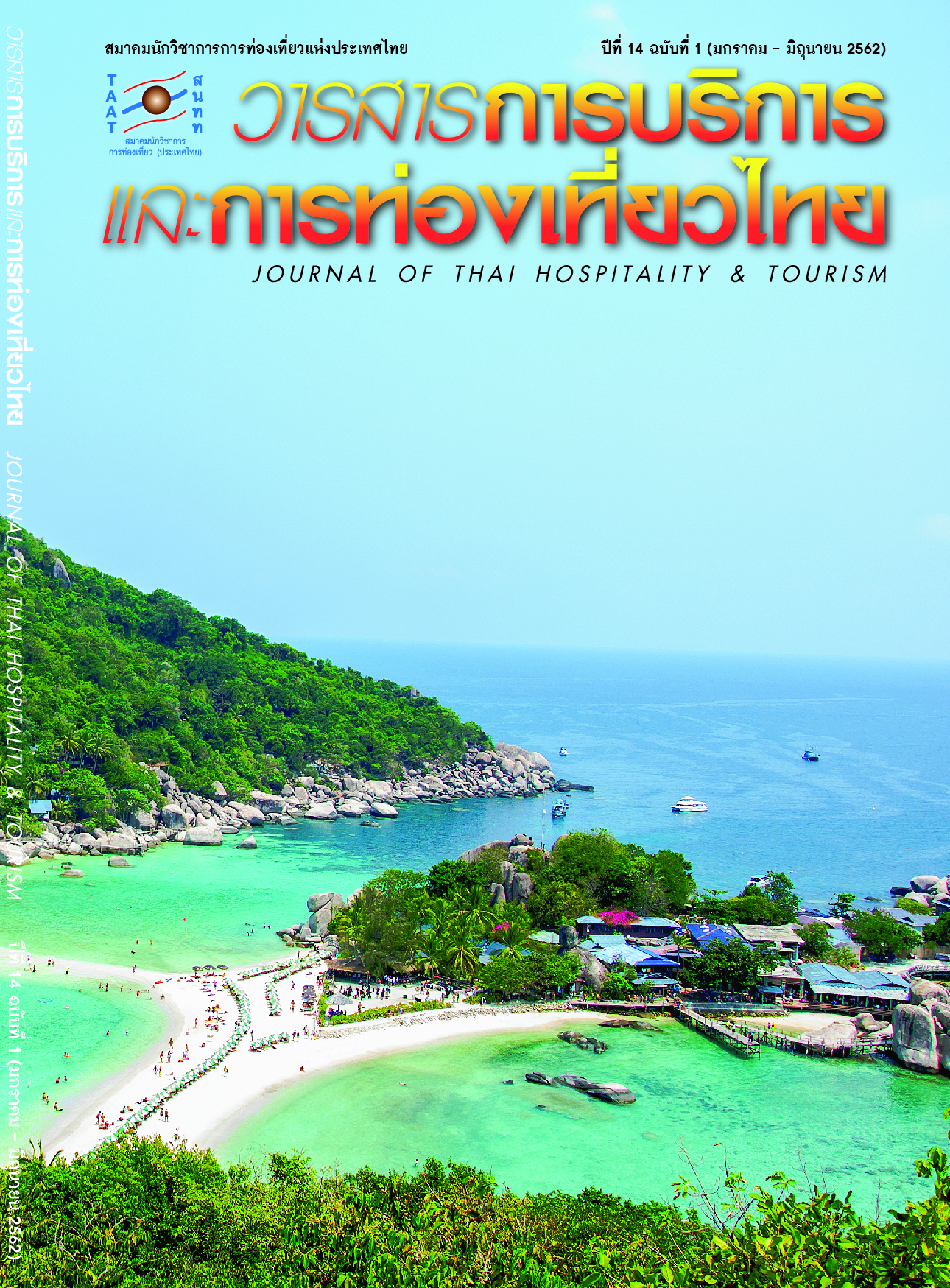โครงสร้างของระบบการท่องเที่ยว
Main Article Content
บทคัดย่อ
การท่องเที่ยวของโลกในปัจจุบันได้มีการปรับเปลี่ยนไปตามการเปลี่ยนแปลงของโลก ไม่ว่าว่าเกิดจากการเปลี่ยนแปลงทางด้านเทคโนโลยี หรือพฤติกรรมของนักท่องเที่ยว ที่มีผลมาจากวัฒนธรรม หรือโครงสร้างทางประชากร แต่อย่างไรก็ตาม การเปลี่ยนแปลงดังกล่าวย่อมทำให้การศึกษาด้านการท่องเที่ยวเปลี่ยนแปลงไปด้วย ดังนั้นระบบการท่องเที่ยว จึงเป็นภาพสะท้อนถึงการอธิบายที่เกี่ยวกับความเชื่อมโยงการท่องเที่ยว
ไว้เข้าด้วยกันโดยไม่มองแบบแยกส่วน อีกทั้งยังสามารถนำมาอธิบายกระบวนการพัฒนา การบริหารจัดการ ในส่วนต่าง ๆ ได้อย่างชัดเจน การสร้างระบบการท่องเที่ยว ได้ใช้แนวคิดทางด้านรูปแบบทางเศรษฐศาสตร์
เข้ามาประยุกต์ คือ กำหนดระบบการท่องเที่ยวเป็น 4 คือ ด้านความต้องการ ด้านการสนับสนุน ด้านการตอบสนอง และด้านการเชื่อมโยง
Article Details
รูปแบบการอ้างอิง
มัธยมบุรุษ ว. (2019). โครงสร้างของระบบการท่องเที่ยว. วารสารการบริการและการท่องเที่ยวไทย, 14(1), 94–102. สืบค้น จาก https://so04.tci-thaijo.org/index.php/tourismtaat/article/view/175101
ประเภทบทความ
บทความวิชาการ
เอกสารอ้างอิง
[1] Akkaranggoon, Supalak. (2005). Tourist Behavior. 2nd ed. Khon Kaen: Klang Nana Witaya Co. Ltd.
[2] Baramechai, Jutamas., Na-Ranong, Wichit., Chokwatana, Narong., & Phayakvichien, Pradech. (2007). Summary of the Workshop on Thai Tourism on Sufficiency Economy. Bangkok: National Legislative Assembly.
[3] Cooper, C., Gilvert, D., Fyall, A., Fletcher, J., & Wanhill, S. (2005). Tourism: Principles and Practices. 3rd ed. London: Pearson Education.
[4] Goeldner, C. R. & Ritchie, J. R. B. (2012). Tourism: Principles, Practices, Philosophies. 12th ed. New York: John Wiley & Sons.
[5] Hall, C. M. & Page, S. J. (2002). The Geography of Tourism and Recreation. 2nd ed. Kentucky: Routledge.
[6] Jittangwattana, Boonlert. (2005). Tourism Industry. Bangkok: Thammasat Press.
[7] Khemthong, Suree. (2011). Introduction to Tourism Industry. Nonthaburi: Sukhothai Thammathirat Open University Press.
[8] Khemthong, Suree. (2011). Introduction to Tourism Marketing. Nonthaburi: Sukhothai Thammathirat Open University Press.
[9] Madhyamapurush, Warach. (2009). A Model of Longstay Tourism Management for Japanese Tourist in Chiangmai. Chiang Mai : Maejo University.
[10] Madhyamapurush, Warach. (2011). Development of Participatory Learning Pathways for Elderly Travelers,
A Case Study of Mae Moh Power Plant Area and Communities around Lampang Province. Northern Region Research Administration Network Office of the Higher Education Commission.
[11] March, R. G. & Woodside, A. G. (2005). Tourism Behavior: Travelers’ Decisions and Actions. Massachusetts: Pul CABI.
[12] Mill, C. & Morrison, A. M. (2012). The Tourism System. 7th ed. Kendall Hunt Publishing Company.
[13] Ministry of Tourism and Sport. (2015). Thailand Tourism Strategy 2015-2017. Thailand: Ministry of Tourism and Sport.
[14] Pimonsompong, Chalongsrl. (2015). Tourism Planning and Marketing Development. 5th ed. Bangkok: Kasetsart University Press.
[15] Ross, G. F. (1998). The Psychology of Tourism. 2nd ed. Melbourne: Hospitality Press.
[16] Swarbrooke, J., & Horner, S. (2005). Consumer Behavior in Tourism. 2nd ed. London: Butterworth-Heinemann.
[2] Baramechai, Jutamas., Na-Ranong, Wichit., Chokwatana, Narong., & Phayakvichien, Pradech. (2007). Summary of the Workshop on Thai Tourism on Sufficiency Economy. Bangkok: National Legislative Assembly.
[3] Cooper, C., Gilvert, D., Fyall, A., Fletcher, J., & Wanhill, S. (2005). Tourism: Principles and Practices. 3rd ed. London: Pearson Education.
[4] Goeldner, C. R. & Ritchie, J. R. B. (2012). Tourism: Principles, Practices, Philosophies. 12th ed. New York: John Wiley & Sons.
[5] Hall, C. M. & Page, S. J. (2002). The Geography of Tourism and Recreation. 2nd ed. Kentucky: Routledge.
[6] Jittangwattana, Boonlert. (2005). Tourism Industry. Bangkok: Thammasat Press.
[7] Khemthong, Suree. (2011). Introduction to Tourism Industry. Nonthaburi: Sukhothai Thammathirat Open University Press.
[8] Khemthong, Suree. (2011). Introduction to Tourism Marketing. Nonthaburi: Sukhothai Thammathirat Open University Press.
[9] Madhyamapurush, Warach. (2009). A Model of Longstay Tourism Management for Japanese Tourist in Chiangmai. Chiang Mai : Maejo University.
[10] Madhyamapurush, Warach. (2011). Development of Participatory Learning Pathways for Elderly Travelers,
A Case Study of Mae Moh Power Plant Area and Communities around Lampang Province. Northern Region Research Administration Network Office of the Higher Education Commission.
[11] March, R. G. & Woodside, A. G. (2005). Tourism Behavior: Travelers’ Decisions and Actions. Massachusetts: Pul CABI.
[12] Mill, C. & Morrison, A. M. (2012). The Tourism System. 7th ed. Kendall Hunt Publishing Company.
[13] Ministry of Tourism and Sport. (2015). Thailand Tourism Strategy 2015-2017. Thailand: Ministry of Tourism and Sport.
[14] Pimonsompong, Chalongsrl. (2015). Tourism Planning and Marketing Development. 5th ed. Bangkok: Kasetsart University Press.
[15] Ross, G. F. (1998). The Psychology of Tourism. 2nd ed. Melbourne: Hospitality Press.
[16] Swarbrooke, J., & Horner, S. (2005). Consumer Behavior in Tourism. 2nd ed. London: Butterworth-Heinemann.


